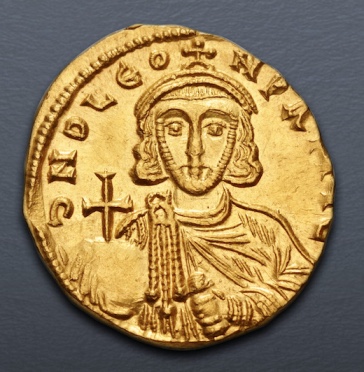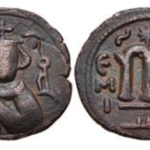
The first codices of the (Judaeo-Christian) Qur’ān were those compiled by the Caliph ‘Abd al-Malik ibn Marwān and Al-Ḥajjāj ibn Yūsuf al-Thaqafī, for the purpose of composing a holy book for the Muslims. For the term ‘Islam’ was not in use as a credal definition until the end of the reign of Caliph Abd al-Malik ibn Marwān. Before this time they were referred to as ‘Hagarenes’ or ‘Ishmaelites’ or ‘Saracens’.
BY NAFI SHABOU
CONFIRMING WHAT AL-KINDĪ said concerning the burning of the six recensions of the Qur’ān during the reign of ‘Abd al-Malik ibn Marwān and Al-Ḥajjāj ibn Yūsuf al-Thaqafī, there is a letter from the Byzantine Emperor Leo III to the later Umayyad caliph ‘Umar ibn ‘Abd al-‘Azīz, which runs:
We know that it was ‘Umar, Abū Turāb (‘Alī ibn Abī Ṭālib) and Salmān the Persian, who composed [your Furqān, i.e. the Qur’ān] even though the rumour has got round among you that God sent it down from the heavens … As for your (book), you have already given us examples of such falsifications, and one knows, among others, of a certain Ḥajjāj, named by you as Governor of Persia, who had men gather up your ancient books, which he replaced by others composed by himself, according to his taste, and which he propagated everywhere in your nation, because it was easier by far to undertake such a task among a people speaking a single language. From this destruction, nevertheless, there escaped a few of the works of Abū Turāb, for Ḥajjāj could not make them disappear completely. [1]
From the foregoing essays in this series we may reach the following conclusions:
1 – The Qur’ān is a book written by some monks that were outside of official Christianity (Christian heretics and innovators), which was translated into the old (Hijazi) Arabic language and which owed its deviations to non-canonical Judaeo-Christian Gospels. The term ‘Qur’ān’ itself in Syriac (ܩܪܝܢܐ qeryānā) denotes a ‘reading’ of Bible chapters.
2 – These authors of the earliest Qur’ān were mentioned in the Islamic tradition, and include the monk Baḥīra, the monk Sergius (Nestorius) and the priest Waraqa ibn Nawfal.
Islam crystallized from Christianity (Judaeo-Christianity) into an independent religion
3 – But after these monks had passed away Muḥammad made some alterations and additions and turned back toward Arab pagan religious practices, in particular the worship of the Black Stone, and subsequently altered the first qibla which was directed towards Jerusalem (Solomon’s Temple) towards the Ka‘ba, and made the claim that Islam was the religion of Abraham.
4 – Muḥammad passed away before the Qur’ān had been collected, and therefore the succeeding caliphs, whether Abu Bakr or ‘Uthmān ibn ‘Affān, tasked themselves with collecting this Qur’ān. However, there differences in readings meant that there were two divergent and conflicting readings, abrogating and abrogated verses, additions and deletions. This was the reason that the earliest Qur’āns were burned (22 of them according to Al-Sijistānī) with just the one retained, known as the Qur’ān of ‘Uthmān.
Nevertheless, the problem did not end there due to the fact that other Qur’āns were in circulation in lands that had been conquered by Muslims. For these reasons sedition developed in Islam: ‘Uthmān ibn ‘Affān was assassinated for having burned the earliest Qur’āns and for having formed a committee to collate together the recensions to form one single Qur’ān, named the ‘Uthmān muṣḥaf. According to the Islamic heritage ‘Ā’isha along with some of the Companions stood behind ‘Uthmān’s assassination.
In the era of the Umayyads, during the caliphate of ‘Abd al-Malik ibn Marwān, Al-Ḥajjāj ibn Yūsuf al-Thaqafī composed another Qur’ān and consigned other Qur’āns that contradicted the views and beliefs of the Umayyad caliphs to the flames.
5 – From the outset many hands were involved in the circulation of the Qur’ān, as stated above. The Qur’ān thus passed through some evolutionary stages during which Zoroastrian, Mazdakian, Manichaean, Arian, Ebionite and Gnostic beliefs were incorporated into it. This was particularly so during the Abbasid era where all the composers of the sīra (the Prophet’s biography) and the hadiths hailed from Khorasan and Persia. These translated the Qur’ān into the innovated Arabic language we are now familiar with. It was here that conflicting and contradictory interpretations of the Text emerged, interpretations which altered many of the meanings of the Qur’ān as a result of the pointing, vocalisations and alterations of the early letters in the text of the original Qur’ān.

Suggested Reading
6 – The closing lines in the Epistle of Al-Kindī indicate that many prophets appeared during the era of Muḥammad who also themselves had different ‘Qur’ān’ books composed for them. Al-Kindī writes:
Musaylima al-Ḥanīfī, al-Aswad al-‘Ansī, Ṭulayḥa ibn Khuwaylid al-Asadī and others did the same work as the Arab Muḥammad. I testify that I have read such a Qur’ān by Musaylima that if it were shown to your companions (i.e. Muslims) most of them would apostatize. But no armed anṣār (supporters) were available to him as were available to your master.[2]
That is, the composition of the Qur’ān was not the sole product of the Arab Muḥammad, since there were translations available for the Qur’ān in the Syriac language, which we discussed above, as a result of the spread of ‘Nazarene’ Christian heresies among the Arabs. In this regard, Muḥammad Āl ‘Īsā observes the following in his book The History of Early Islam:
The idea of multiple authors for the Qur’ān or compilers of the Qur’ān or even translators is confirmed by the large number of contradictions and objective differences, as well as the divergences in style. This points to different authors. Each writer had his own style, his own stamp and spirit that can be felt in the text. But the idea of a committee convened to compose it doesn’t make sense. More logical is that they collected what they found in various sources and polished them into an Arabic tongue.
Many reputable researchers now believe that the first integrated Qur’ānic text, ready for reading as it now is, was set down in the tenth century AD (i.e. the 3rd century AH during the ‘Abbasid era). Manuscripts preceding this date bear different readings, such as the Ṣan‘ā’ recension. Many researchers are minded to understand the Qur’ān was a text written, edited and revised by the Arabs of Syria and Iraq, and contained different readings, and that it took centuries before appearing in its final version that we know today.
In the same way that the Qur’ān evolved into what it has become today, so Islam crystallized from Christianity (Judaeo-Christianity) into an independent religion made up of a strange combination of different religions such as Judaism, (heretical) Christianity, Zoroastrianism, Mazdakism, Buddhism and even pagan religions that were widespread in the Middle East.
In articles to follow we will investigate the sources for this Qur’ānic synthesis. This is a most important topic through which we may demonstrate that (the current) Islam is a composite of the beliefs, religions, myths and legends of the ancients.
[1] For Arthur Jeffery’s analysis of this correspondence, see https://archive.org/details/Jeffrey1944HTRGhevond/page/n1/mode/2up The above quotation is on pp.292 and 297-8 (Ed.).
[2] Maslama ibn Ḥabīb (d.632) – pejoratively known by Muslims as Musaylima (‘Little Maslama’) and Musaylima al-Kadhdhāb (‘Musaylima the Arch-Liar’) – claimed prophethood in opposition to Muhammad, and at one point amassed a following the equal of Muḥammad’s, with whom he unsuccessfully proposed an alliance. After Muḥammad’s death he was a leader of the enemies of the early Muslims during the Ridda (‘Apostasy’) wars. Little is know of his teachings, other than that he claimed, like Muḥammad, to receive revelations from God, while historians have preserved some extracts of his saj‘ rhymes that resemble the saj‘ rhymes of the Qur’ān (on this see Almuslih essay: The saj‘-rhymes in the Qur’ān. A 17th century Indian work called the Dabestan-i Mazaheb features a religion called the Ṣādiqiyya which claimed to follow the teachings of Musaylima, among which were that he taught three daily prayers to God to be made facing any direction, that he criticised Muslims for selecting the Ka’ba for directing prayers toward, arguing that God is not limited to one direction, that the Ka’ba was not the house of God, because an all-powerful God has no need for a house, that he prohibited circumcision and believed in equal rights for men and women, prohibiting slavery, polygamy and cousin marriage, and that he forbade the inclusion of his name, or that of any prophet, in worship to God.
Main image: Solidus coin of the Byzantine emperor Leo III the Isaurian, also known as ‘the Syrian’ (Λέων Γ΄ ὁ Ἴσαυρος, c. 685 – 18 June 741).
On this essay read the earlier sections: Part One; Part Two; Part Three; Part Four; Part Five, Part Six; Part Seven; Part Eight; Part Nine, Part Ten, Part Eleven, Part Twelve
